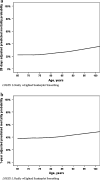ICU admission characteristics and mortality rates among elderly and very elderly patients
- PMID: 22797350
- PMCID: PMC5718912
- DOI: 10.1007/s00134-012-2629-6
ICU admission characteristics and mortality rates among elderly and very elderly patients
Abstract
Purpose: The effect of advanced age per se versus severity of chronic and acute diseases on the short- and long-term survival of older patients admitted to the intensive care unit (ICU) remains unclear.
Methods: Intensive care unit admissions to the surgical ICU and medical ICU of patients older than 65 years were analyzed. Patients were divided into three age groups: 65-74, 75-84, and 85 and above. The primary endpoints were 28-day and 1-year mortality.
Results: The analysis focused on 7,265 patients above the age of 65, representing 45.7 % of the total ICU population. From the first to third age group there was increased prevalence of heart failure (25.9-40.3 %), cardiac arrhythmia (24.6-43.5 %), and valvular heart disease (7.5-15.8 %). There was reduced prevalence of diabetes complications (7.5-2.4 %), alcohol abuse (4.1-0.6 %), chronic obstructive pulmonary disease (COPD) (24.4-17.4 %), and liver failure (5.0-1.0 %). Logistic regression analysis adjusted for gender, sequential organ failure assessment, do not resuscitate, and Elixhauser score found that patients from the second and third age group had odds ratios of 1.38 [95 % confidence interval (CI) 1.19-1.59] and 1.53 (95 % CI 1.29-1.81) for 28-day mortality as compared with the first age group. Cox regression analysis for 1-year mortality in all populations and in 28-day survivors showed the same trend.
Conclusions: The proportion of elderly patients from the total ICU population is high. With advancing age, the proportion of various preexisting comorbidities and the primary reason for ICU admission change. Advanced age should be regarded as a significant independent risk factor for mortality, especially for ICU patients older than 75.
Figures


References
-
- Oeppen J, Vaupel JW. Demography. Broken limits to life expectancy. Science. 2002;296:1029–1031. - PubMed
-
- de Rooij SE, Govers A, Korevaar JC, Abu-Hanna A, Levi M, de Jonge E. Short-term and long-term mortality in very elderly patients admitted to an intensive care unit. Intensive Care Med. 2006;32:1039–1044. - PubMed
MeSH terms
Grants and funding
LinkOut - more resources
Full Text Sources
Medical

